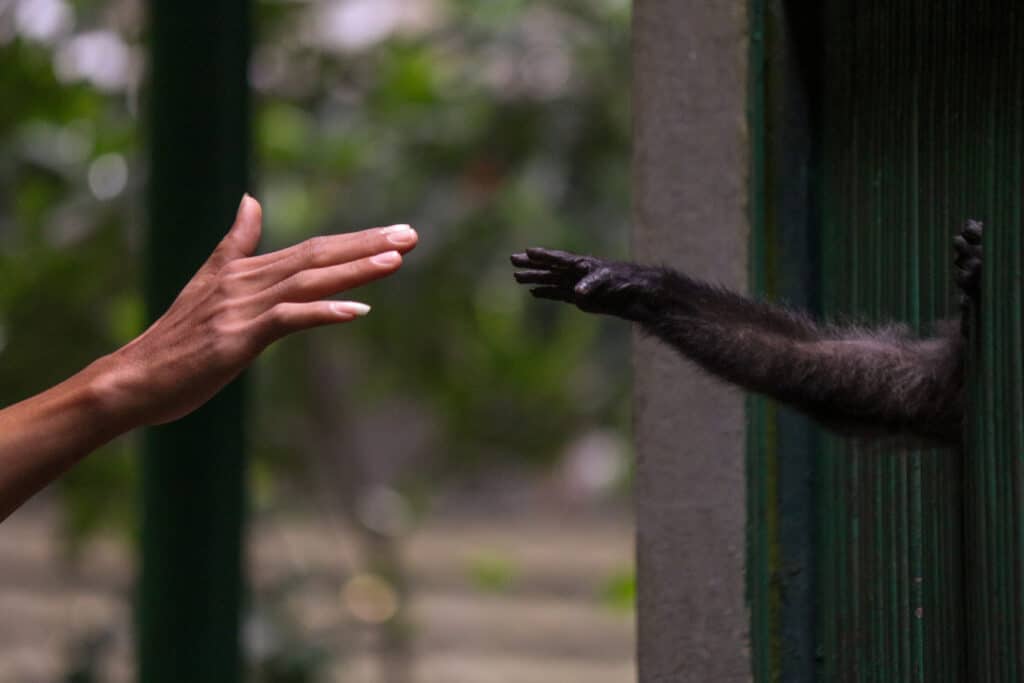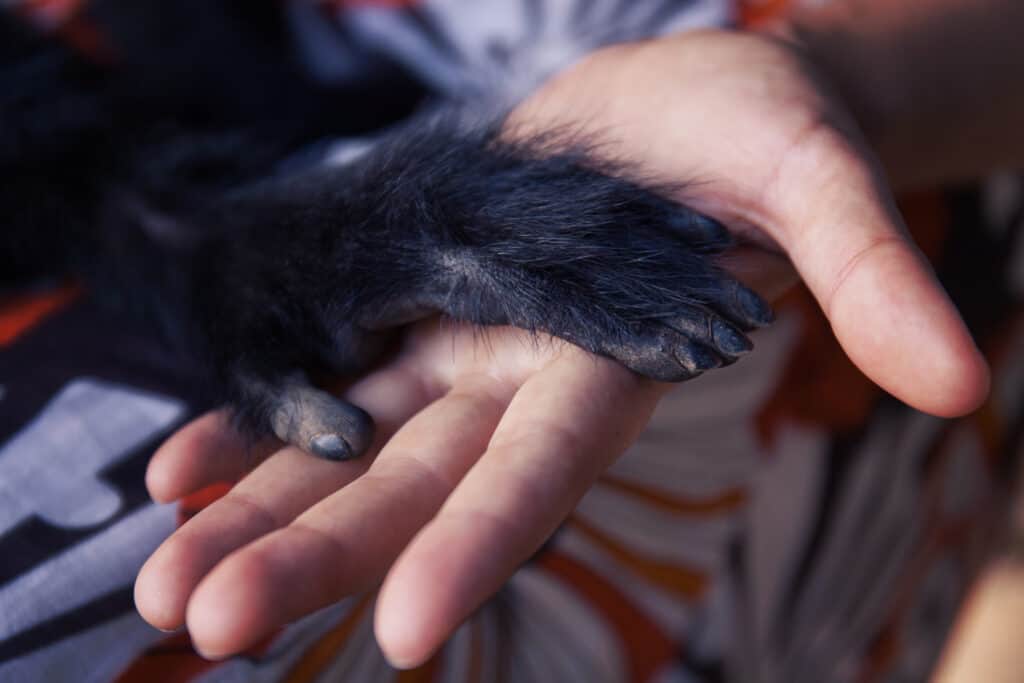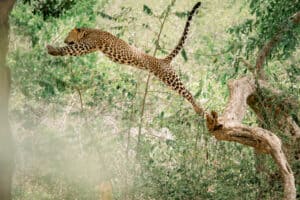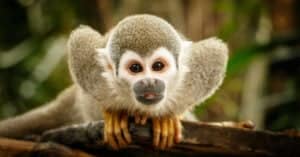How many fingers monkeys have and other facts are quite a mystery. Did you know that different monkey species have varying numbers of fingers? For example, most primates have five fingers on each hand. However, some species only have four. And how about those thumb-less monkeys? Monkey fingers are fascinating. There are lots of fun facts about monkey fingers that you may not know. But keep reading to learn more about the digits of these primates.
A Monkey’s Index Finger Is Twice the Length of Its Thumb
It seems strange and looks stranger, but a monkey’s index finger is twice the length of its thumb. This aspect improves its climbing and grasping ability when moving along tree branches. The longer index finger helps them to maintain a better grip. Additionally, the longer index finger provides more leverage, which is helpful when pulling themselves up.
The extra length of a monkey’s index finger also gives them greater dexterity. This agility helps the monkeys perform delicate tasks, such as picking insects off leaves or grooming themselves and others. So basically, the longer index finger allows monkeys greater control over their hand movements and to better manipulate small objects.

Some monkeys have four fingers and an opposable thumb like humans do.
©indra sianipar/Shutterstock.com
Strong Monkey Index Finger Muscles
Did you know that the controlling muscles of a monkey’s index finger are some of the strongest in its body? It’s true! Why is this muscle so strong? Scientists believe it is because the monkey needs to grip things securely when swinging from branch to branch. This index finger muscle is also so strong that it allows monkeys to support their entire weight when holding onto trees and branches without falling.
Monkeys and Tight Opposable Thumb Grips
As you probably know, monkeys are very agile creatures. They can swing through trees and climb branches with ease. This agility is mainly due to their opposable thumbs. An opposable thumb is one that the monkeys use in opposition to the other fingers on their hands. This ability enables a tight grip, essential when swinging between branches at great heights. However, not all monkey species have opposable thumbs, although most do. For example, lesser-known species such as the marmosets and tamarins also have opposable thumbs. So, the next time you see a monkey swinging through the trees, remember that their opposable thumbs are what give them that amazing dexterity.
Thumbs, Sensitive Pads, and Monkey Grips
Monkey’s thumbs also have very sensitive pads on the bottom. Known as the thenar eminence, this pad is full of nerve endings, making it very sensitive to touch. This perceptiveness is what allows monkeys to grip things so tightly. The thenar eminence is also evident in humans, although it’s not quite as developed. Still, it’s responsible for our ability to grip and hold onto things.
Monkey Digits and Tools
Some monkeys can use their fingers and thumbs to manipulate sticks or rocks, which they use for hunting or gathering food. This capability is unique to primates and is not present in any other type of animal.
Monkeys Have Fingerprints
Did you know that monkeys have fingerprints? That’s right – just like humans, these furry creatures have patterns in their skin that are like fingerprints. Usually, in monkeys, fingerprints will be unique to a species rather than an individual.
So how do monkeys get their fingerprints? Like humans, monkeys have ridges on the skin of their hands and feet with pattern imprints. These imprints occur from differences in the thickness of the skin. The patterns form during fetal development and remain with little change throughout the monkey’s life. Scientists think that this attribute probably evolved for better grasping of objects.
Interestingly, not all monkeys have fingerprints. For example, some new world monkeys, including capuchins and squirrel monkeys, do not have definitive fingerprints. However, gorillas and chimpanzees, which are apes, not monkeys, have unique and individual fingerprints, just like people.
Some Monkeys Have No Thumbs

Black spider monkeys have no thumbs but use their four curved fingers as hooks.
©iStock.com/alexandragl1
Some monkeys have no thumbs. Instead, they use their toes for gripping objects. Some examples of thumb-less primates are the spider and the howler monkeys. The spider monkey inhabits forests in Central America and South America. They use their four long fingers as hooks to scoop items up. Howler monkeys also lives in Central and South America. They have a unique way of grasping things between their second and third fingers, although they also have opposable big toes. In addition, the spider and howler monkeys have prehensile tails that operate as extra limbs for gripping.
Fun Monkey Finger Facts To Take Away
- Diverse monkey species have different numbers of digits. For example, baboons have five fingers on each hand, while spider monkeys have only four.
- Howler monkeys are one of the few species that don’t have opposable thumbs. This absence of opposable thumbs means they can’t grasp something as we can.
- Some monkeys, like spider monkeys, have very long, slender fingers of similar size. But they do not have any thumbs.
- Most monkeys have nails on their fingers, but a few species don’t. For example, gibbons have claw-like nails instead of flat nails.
- The largest primate in the world, the gorilla, has fingers that are longer and bigger than that of people.
- There is a monkey called a finger monkey because it’s only as big as an adult human’s index finger.
So, there you have it, some fun facts about monkey fingers. Next time you see a monkey at the zoo, look closely at its hands and see how many fingers it has. You might be surprised!
Next Up – Interesting Things You May Not Know About Monkeys
Look at these fascinating blogs we have on our site. You might learn something new!
- Monkey Teeth: Everything You Need to Know
- What Do Monkeys Eat? Their Diet Explained
- 9 Monkey Breeds That People Keep as Pets
- The 10 Smallest Monkeys in the World
The photo featured at the top of this post is © Nicktopus/Shutterstock.com
Thank you for reading! Have some feedback for us? Contact the AZ Animals editorial team.






